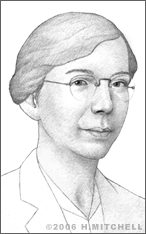Florence Seibert
Biochemist Florence Barbara Seibert developed a groundbreaking procedure that led to the standard tuberculosis test used to detect the potentially deadly virus in infants, children and adults around the world in the 1930s.
Born in Easton, Pennsylvania on October 6, 1897, Seibert contracted polio as a small child and lived for the rest of her life with a slight disability that affected the way she walked. This challenge did not interfere with her work; rather she excelled in her studies and earned a BA from Goucher College in Baltimore in 1918 where she studied chemistry and zoology. From there she moved on to Yale University where she completed a PhD in Biochemistry in 1923.
As part of her graduate work, with advisor Dr. Lafayette Mendel, Seibert worked on a method of eliminating bacterial contamination that was known to occur during the creation of solutions meant for vaccinations and injections. Patients could experience sudden fevers or illness during or after an injection or intravenous treatment. Such afflictions, Seibert discovered, were most often caused by bacterial contamination of the distilled water used to make the solutions. She was able to eliminate this contamination using a special apparatus and procedure she created for this purpose. This would be a great boon later not only for administering drugs but also for making blood transfusions safer during surgery.
Seibert became a Porter Fellow at the University of Chicago, and served as a pathology instructor there from 1924 to 1928. She became an assistant professor of biochemistry in 1928. In 1932, she accepted a post as assistant professor of biochemistry at the University of Pennsylvania’s Henry Phipps Institute, where she would spend the rest of her career.
While working for the Phipps Institute, Seibert traveled widely, working with such institutions as the University of Uppsala in Sweden. In the mid-1930s her work culminated with her development of the purified protein derivative, or PPD, that would become the basis for what is today known as the Standard TB Test.
Tuberculosis is a relatively rare bacterial infection that primarily affects the lungs. It can infect and become dormant for months or years, but once detected, it is treatable with a course of antibiotics over several months. Active TB is highly contagious, however and affects less than one percent of the U.S. population. About 500 people die from tuberculosis every year in the U.S.
Seibert’s breakthrough procedure was readily accepted by the medical community. In 1938 she was awarded the Trudeau Medal from the National Tuberculosis Association for this work. Her TB test became standard in the United States in 1941, and a year later, was adopted by the World Health Organization as well. That year, the American Chemical Society awarded her the Garvan Medal.
Seibert rose to the rank of full professor at the Phipps Institute and, upon retirement in 1959, she was appointed professor emeritus. She did not stop working that year, however. Rather she changed focus, and began working on a largely volunteer basis for 30 more years. During these last years of her life, she focused on research examining the etiology of cancer, particularly cancers posing grave risk to women, including breast cancer. In 1990 she was inducted into the National Women’s Hall of Fame. She died on August 23, 1991, at the age of 93.


